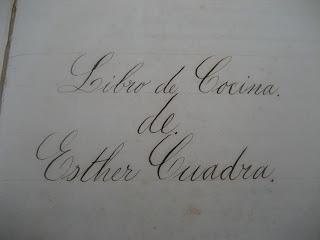Cookbooks of any era are marvelous eyepieces for glimpsing into a particular time and place and for gathering clues about how people lived, cooked and ate. I’m glad I had the presence of mind to shoot a few photos of what was in front of me–I just wish I’d taken more. These books are treasures, not just for their recipes, but because they provide a unique form of time travel.
Fifty Years in a Maryland Kitchen, published in 1873, was written by a woman whose name we do not know. Identified as Mrs. B.C. Howard, we are only sure who she married. Some of the recipes are quite simple, as in the instructions for roasting pheasant: Roast the pheasant the same way you do a chicken. The implication is that everyone already knows how to roast a chicken, an assumption you can’t make today.Other recipes are for dishes you just don’t see on menus and in cookbooks nowadays, as in “Veal Bewitched”:
 The recipe notes that veal bewitched tastes like boned turkey. These days turkey costs much less than veal, so during the time in which this book was written, veal must have been the bargain meat, and this description would have encouraged cooks to give the dish a try. Speaking of things you won’t find in a menu or a cookbook these days, the words “meat” and “jelly” seldom appear on the same page, much less in the same phrase.
The recipe notes that veal bewitched tastes like boned turkey. These days turkey costs much less than veal, so during the time in which this book was written, veal must have been the bargain meat, and this description would have encouraged cooks to give the dish a try. Speaking of things you won’t find in a menu or a cookbook these days, the words “meat” and “jelly” seldom appear on the same page, much less in the same phrase.
The 1904
Blue Grass Cook Book by Minnie C. Fox (well, this is a step in the right direction, as there’s no indicator this time of marital status) includes a collection of photos, not of particular dishes or ingredients or even kitchens. No, throughout the book are photos like this one: I doubt it was the author’s intent to make us all cringe while looking through her cookbook (she probably never envisioned someone from 2008 even finding it). But it’s difficult not to, when you see images like this with captions like this. I have to keep reminding myself that this is simply the way it was then. This is history preserved for our consideration.
I doubt it was the author’s intent to make us all cringe while looking through her cookbook (she probably never envisioned someone from 2008 even finding it). But it’s difficult not to, when you see images like this with captions like this. I have to keep reminding myself that this is simply the way it was then. This is history preserved for our consideration.
Her recipes include instructions that few home cooks have to follow anymore: “Kill your hogs when the wind is from the northwest.” If you are unsure about how to cook your ham, on account of its age, you’re instructed: “Never bake a ham under a year old.” If it’s an old one, you’re instructed: “Scrub well and soak an old ham in plenty of water for 48 hours.”
It includes instructions for opening and dressing a terrapin. How many people today even know what a terrapin is without googling it? (And how many people 104 years from now will know what “googling” means in this dusty old blog that somehow has survived?)
By the way, I just love the author’s name, Minnie Fox. Wonder if she was petite, with red hair, pointy features and a fondness for barnyard fowl?
One particularly rare and valuable cookbook was set down by hand in a most beautiful pen. No one writes like this anymore:
 I’m guessing Esther made an A in penmanship.
I’m guessing Esther made an A in penmanship.
 This cookbook is in two volumes, one of which includes an index of recipes. I’d say our scribe had a thing for organization. Unfortunately, I can’t read Spanish, beyond the rudimentary (abierto, cerado, baños), so I must leave the secrets of history locked in her recipes for someone else to discover.
This cookbook is in two volumes, one of which includes an index of recipes. I’d say our scribe had a thing for organization. Unfortunately, I can’t read Spanish, beyond the rudimentary (abierto, cerado, baños), so I must leave the secrets of history locked in her recipes for someone else to discover.
I began this line of thought back in the summer with a blog that mentioned my 1930s New Orleans cookbook. Makes me want to revisit it (if you’re interested, take a look at my blog of July 30, 2008, “Hand-Wringing Over Neck-Wringing”). There’s a world of New Orleans history inside that tiny tome on cooking, just as there’s a world of history inside most every cookbook.
















